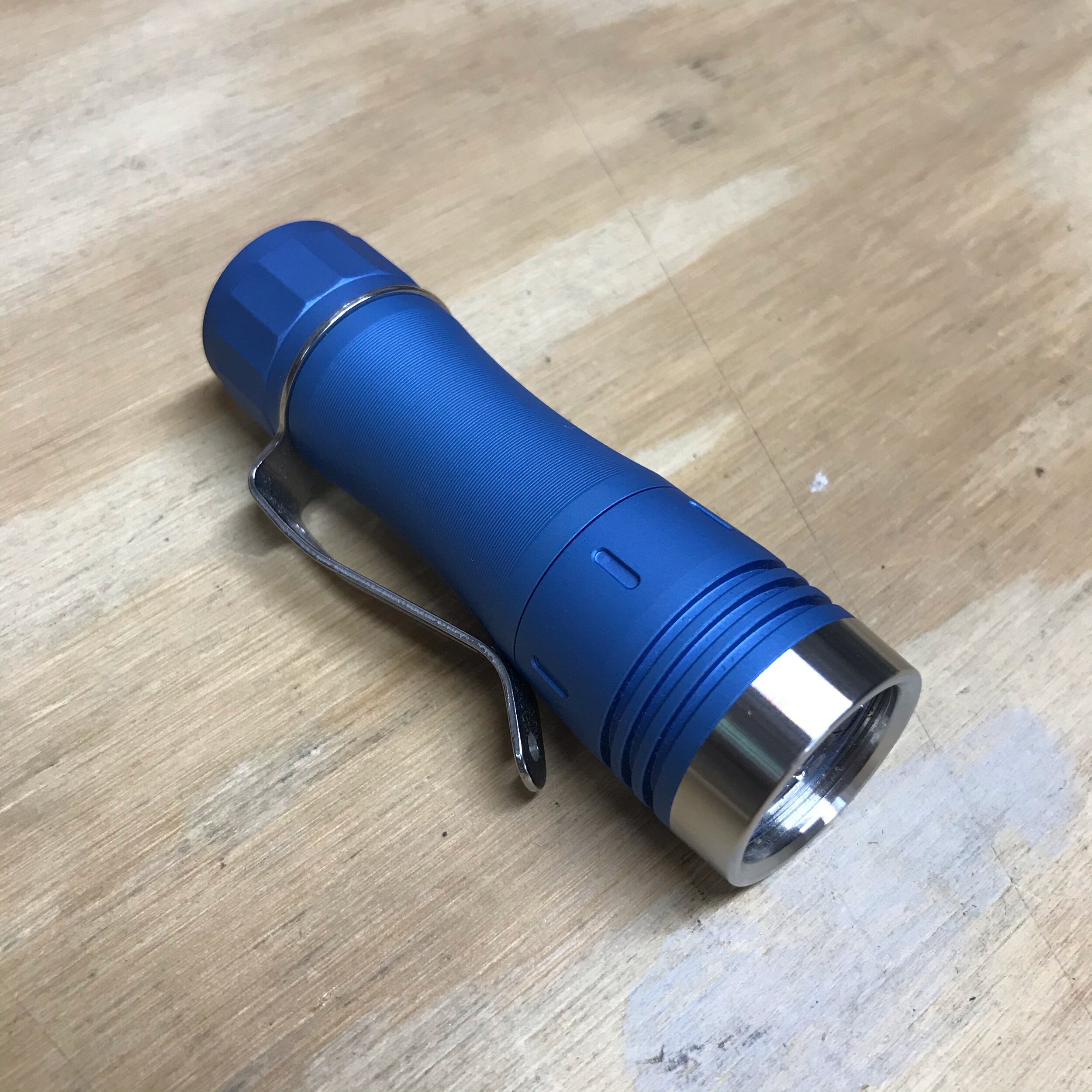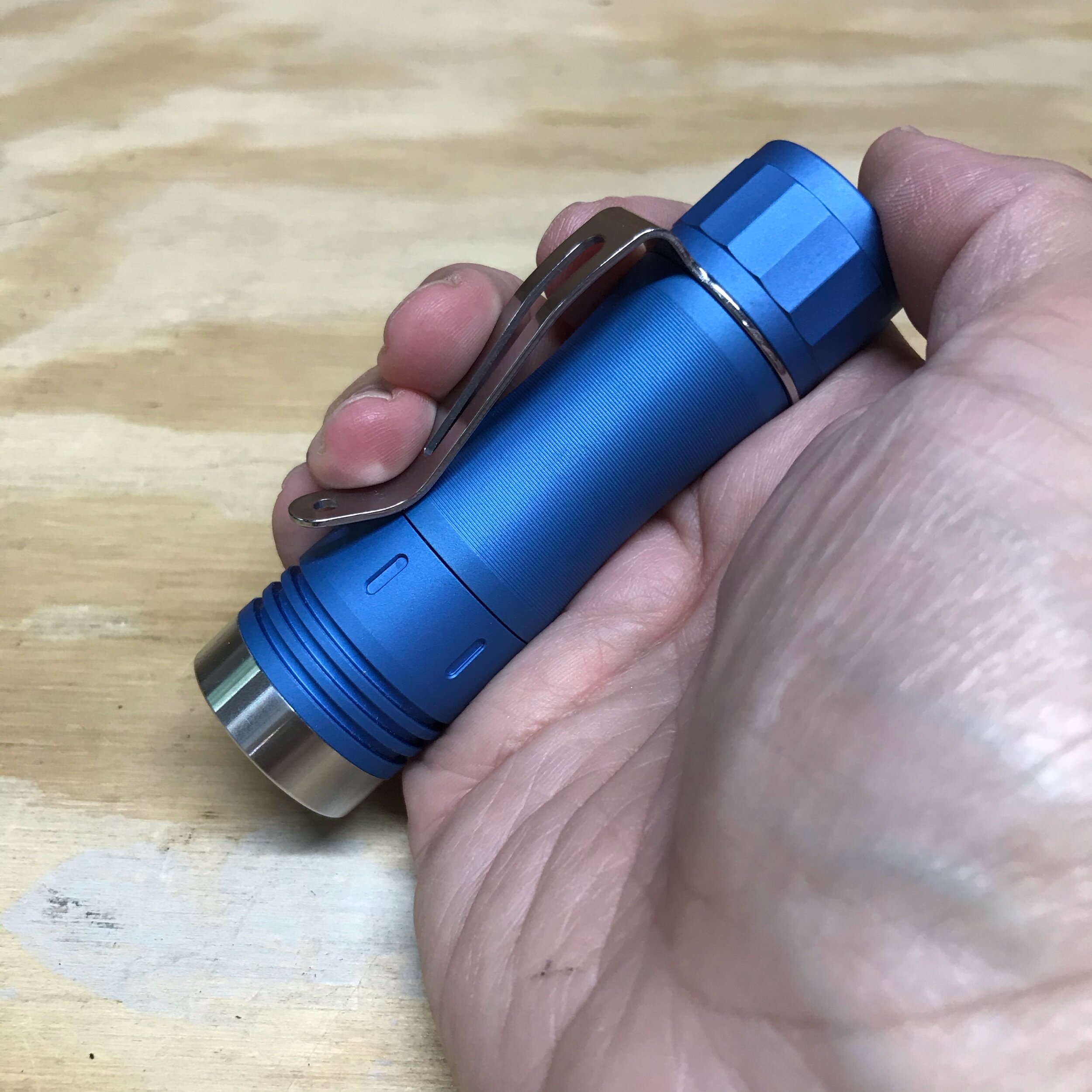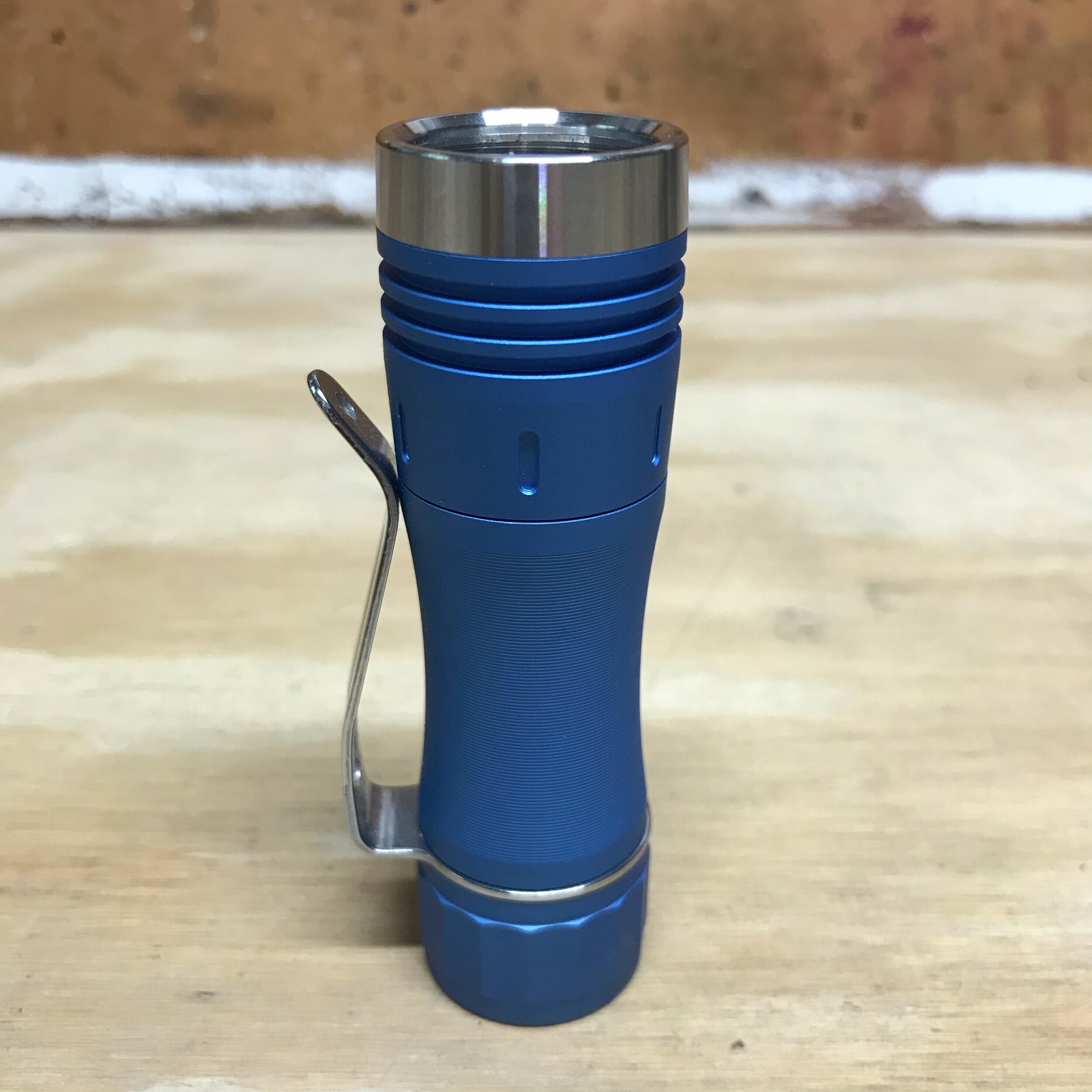Noctigon KR4 Review
There are two vastly different flashlight universes out there and rarely do the two cross paths. For many years, I have been comfortably ensconced in one but mindful of the other. Over the past three months, I have decided to venture out and I have been rewarded with two incredible lights: the Lumintop GT Micro (review coming soon) and this light, the Noctigon KR4. While what I am about to write is a gross simplification and I know that there is cross pollination between the two universes (see: Zero Air reviews), it is a useful frame for a review, so I am going to play it out.
The two worlds are basically reflections of the forums that they originated from—CPF and BLF.
CPF or Candlepower Forums has long been home to flashlight fans with virtually unlimited budgets (see: Spy 007 or the even more exotic Tri-V). In recent years this has led to a series of lights that all have pretty basic functionality and okay performance but wickedly complex machining and “exotic” materials. As that train always ends up going straight to crazy town (see e.g. any ebay listing for Burnley’s Cypops), I decided it was time to hop off. I still love me some expensive torches, but I try to confine my purchases to models that have both gee whiz machining and high performance (see my recent review of the Prometheus Delta). Either way, I realized it was time to see what BLF folks were doing.
BLF, or Budget Light Form, was, long ago, populated by reviews of $5.97 zoomie lights from Amazon that were, frankly, not worth even $5.97. But the forum and the lights it liked evolved. Lights like the FW3A came out of BLF and they weren’t just inexpensive, they were also good. Part of this vanguard of new lights is the Anduril UI, developed by Toykeeper. I have a ambivalent relationship with Anduril, documented here (Toykeeper announced Anduril 2.0 during the time I was writing this review, see here). BLF has also been a strong proponent of throw lights, while the CPF folks have focused mainly on EDC-style torches. But the reality is that BLF lights are also better lights on spec. The new Acebeam LEP technology is a perfect example of this (which, at around $250, is hardly “budget”). The laser excited phosphor tech creates a beam that throws well over a mile in a package around the same size as a 2xD Maglight. BLF folks and the light makers that cater to them have really focused in on squeezing out tons of performance from batteries and emitters. But design and build quality, it seemed, lagged behind. The FW3A’s design appears to have drawn up on CAD with no thought whatsoever for the internals. How else do you explain the existence of the dreaded nubbin?
Well, the Noctigon KR4 shows that the BLF lights can hang with he big boys in terms of value, performance design, AND build quality. In fact, the Noctigon KR4 shows that BLF lights are unquestionably the leading edge in value for torches. This is a high watermark light and something that will, in retrospect, mark a break with the past. The amount of performance, design, and customization you get on the Noctigon KR4 is truly next level. The flashlight game has changed and we consumers are reaping the rewards.
As a side note I want to point out just how divergent the knife market is from the flashlight market. In the flashlight market the price for high end performance and build quality is going DOWN. In the knife market it is going UP. How else do you explain the fact that this light costs as much as the knife I just reviewed, the Flash AT? One piece of gear, the knife, was the new benchmark for entry level blades and cost $75. The other, the light, is a highwater mark for bleeding edge performance, and starts out $20 less. I will leave it to you to draw the conclusions you want from this observation.
Here is the product page for the Noctigon KR4. There are too many variations to list here. My review sample came with the following options:
SST Hi CRI emitter
Cyan body tube
Cyan “stubby” body tube (so the light can run on 1x 18350)
Stainless steel replacement bezel
High maH, flat top cell
Tritium slot with cyan tritium insert
All of this cost me about $85 shipped with the base light and cheapest emitter costing $55. Staggering, right? In all I think there are probably roughly 1,000 possible configurations available (this reminds me of what I think of as “easily managed complexity” like how the options for coffee are basically infinite at a coffee shop, but the barista easily navigates those variations—I find this topic endlessly fascinating as it is an example of how humans can do something quickly that machines struggle with and it is also a good example of how traditionally thought of “low skill” jobs cannot be easily outsourced or replaced by machines). Here is a written review of the Noctigon KR4 (1lumen.com should be one of your Gear Review bookmarks, if it isn’t already). Here is a video review. Here is my video overview. Here is my review sample, purchased with my own money and mine to keep:
Twitter Review Summary: A Proustian achievement in flashlights.
Design: 2
The KR4 is a chunk of a light, nothing insane, but definitely noticeable in the pocket. In exchange for that bit of heft you get a do-everything lighting solution with a wide range of customer-selected LEDs, the possibility of a tritium insert, an upgradeable bezel, and one of the best body tubes out there. Combining the fine striations of a Tactile Turn pen and a good hour glass shape the KR4’s form factor is good enough to keep it useful long after its LEDs are no longer cutting edge. But don’t worry, that won’t be for a while, and by “a while” I mean in flashlight time, so, you know, like three months. The choice of an 18650 is not my favorite, but it is not a bad one either, giving the platform plenty of horsepower to blind the universe. This is a top shelf design and different from what we have seen in years prior from BLF lights.
Because of the choice of emitters, performance ratios don’t really work for this light. Suffice to say—its a chunk.
Fit and Finish: 2
Historically, the tradeoff in BLF lights is between eye-exploding output and jalopy fit and finish. The KR4 bucks that trend and gives you a very nice light AND high output. Its not to the level of something like a Prometheus or a Muyshondt, but it is definitely above the feel of a Fenix, oLight, or the like. I would put it on par with Surefire or FourSevens. Compared to the first generation of lights discussed on BLF, that’s like asking for a Toyota and expecting a Corolla but getting the Century instead (it has a wool interior and paint so complex only a handful of master craftsmen inside Toyota can apply it).
Grip: 2
With a pleasing-to-the-hand shape and wonderful texturing (I am DONE with knurling on lights…enough already), this is one of the best EDC lights on the planet in terms of grip. The length to diameter ratio is dialed in and the button is within easy reach of the thumb. In terms of grip, the KR4 is about as good as lights come.
Carry: 1
The light is a chunk, as I mentioned above, but its really an insane clip that makes this light less than ideal in the pocket. The clip’s tension is fine and its placement is good, it just bows out about a half an inch and becomes the world’s best pocket-based paint scraper, door jam shredder, and branch snagger. Please tame down this clip. And if anyone knows of a clip swap that works, drop a note in the comments.
Output: 2
One thing that Anduril gives you is a massive amount of options for output. This light has maxed out everything—main LEDs, auxiliary LEDs, and tons of control over how bright they get and the patterns for output (strobe, etc.). If you can do it with light, this light can do it. Not only that, but you get the brightest or one of the brightest 18650 lights available. It can also sprinkle out the photons, too, when need be.. With all of these options, this light is an output champ. Only dual array lights, like the Muyshondt Beagle, are clearly superior.
Runtime: 2
Again, with Anduril’s flexibility and the ultra low low, you can squeeze out a decent runtime on low. On high, you do okay too, especially once you get past the 4,300 lumen “cheat period” used in the ANSI standard.
BTW, have I ever discussed just how stupid the ANSI max output standard is? Its a joke and designed specifically to allow company’s to cheat on specs. Despite my strong preference for a market-based solution, ANSI is a great example of how government regulation is necessary to protect consumers in certain limited instances.
Basically the light companies decided that the standard way of measuring max output involves how bright a light can get, but only for the first 90 seconds the light is on. As a result, no light on the market can hold its max for longer than 90 seconds (well, the BOSS 35 can, but you have to turn off a bunch of modes and safety features). ANSI is what you get when people with an economic incentive to cheat make the rules. In other words, its what happens when you let the foxes develop the rules for guarding hen houses.
Beam Type: 2
This is not a throw torch at all and it does well, as an area/up close light, but thanks to some serious output it can throw quite well. Additionally, you can get a mule version if you want NO beam shaping. There is not yet a throw version, but it doesn’t seem impossible to do. As it stands the stock KR4 is a very good Goldilocks beam.
Beam Quality: 2
Like with the build quality the beam quality is top notch, lightyears from the garbage of “focus lights” that dominated the BLF forum for years. Its nice to see just how far things have come. I’d put the KR4 right up there with Surefire as one of the best production beams and it is not that far off from the better custom beams. Beautiful.
UI: 0
My feelings on the Anduril UI are not a secret, but I feel a bit bad after I have carried this light for a while. Honestly, I can make it do everything on the list pretty consistently. For a UI that has over 60 different inputs, all with a single button, it works pretty well. The problem is this light cannot be used by anyone other than me. Unlike with the brilliance that is the UI on the HDS Rotary or the RRT 01 v2 Raptor, this is not a light you hand out to others in an emergency. I now know the fear that early 80s parents had of their children screwing up the clock on the VCR after they spent a half hour with the manual and its indecipherable instructions. It kinda cracks me up that that little vestige of shitty design remains the butt of jokes forty years later, but flashlight fans call you a Philistine if you besmirch the name of Anduril.
Let’s be clear: Anduril is a bug not a feature.
Here is what I would do for a clicky UI:
Click from Off: Light on in previous mode
Hold from Off: Light to moonlight
Double Click from Off: Max
Triple Click from Off: Aux LEDs interface
Hold from On: Ramp as implemented here
Unscrew tail cap and remove battery for 1 minute: Factory reset
That’s it. No fuss, no muss, and no stupid strobe modes.
Hands Free: 2
I wouldn’t bite light at all. Its too heavy, but it does stand well and will never roll given how much of a protuberance its clip is.
Other Considerations
Fidget Factor: High
With an excellent grip and a nice e-switch the KR4 is fun to fidget with, but accidentally dropping it into some weird mode or lockout made me less willing to play around with the light initially. Now that I have enrolled in and successfully completed the self-taught 41-part tutorial seminar on Anduril, I am more comfortable handling the KR4.
Fett Effect: Low
Strong mil-spec anodizing and good texturing mean that this light will look new for a good long while, if you like that kind of look.
Value: Very High
This is an extraordinary value—an expectations-recalibrating good value. In many ways this is a custom light for around $55 (without the options I got). You pick the emitter, you pick the color, and you can upgrade it. In many ways this is MORE flexibility than you find on small-batch or custom lights. And honestly, the quality of construction does not suffer much if at all. It is a simpler design than many small batch lights, but it is not a poorer made one.
Overall Score: 17 out of 20
Despite the daunting UI, the difficult-to-find battery, and the weird pocket clip the Noctigon KR4 is an excellent flashlight easily capable of being your only light. If you are willing to devote the time and focus needed to master Anduril (the UI chart, the online manual, and the aforementioned 41-part tutorial seminar), this light is like a Proust novel: challenging but rewarding. If you are looking for an easy light that does things like turn on with a click of a button and change modes with aother click—keep looking. But the dense complexity of the KR4 gives rise to stunning flexibility. Performance-wise the KR4 is a beast, with eye-exploding highs and a dizzying kaleidoscope of colors. The runtimes on low are amazing and the runtimes on high are par for the course. But its the fit and finish, body tube, and tailcap that keep me hooked. This light has a classic form factor that combines the Tactile Turn texture with the HDS hourglass shape, making it supremely good in the hand. Anduril might be a PITA, but here it is in service to a new benchmark in terms of value and performance. Watch out custom makers, this new generation of user-informed BLF-birthed lights is coming for you.
Competition
One of more interesting things about BLF lights is how rapidly they multiple—just look at all of the variants of the FW3A. As such, a truly comprehensive comparison to other lights is difficult. The Lumintop FW3A is an obvious comparison and while I like the clip and weight of the FW3A better, the KR4’s increased output and superior body tube make it better. The lack of the ridiculous nubbin, however, means the KR4 laps the FW3A. The KR4’s stable mate, the side switch Emisar D4 v.2 is basically the same light with fewer emitter options, but I strongly prefer tail switch lights to the often accidentally-activated side switch lights. Broadening the field to the more traditional brands like Fenix, oLight, and Surefire there is really no light that is in the same league in terms of versatility and output. For example, the KR4 is more than twice as bright as the 18650 Baton series light. The new Seeker Pro 2, which sports a larger 27100 battery, is still “only” 3200 lumens, far short of the KR4’s high. It used to be that the big differentiator was build quality, but the KR4 is as nice or nicer than most production lights out there. No thread slop or grit, no off-centered emitter, nothing of the sort. Even high end custom lights can’t match the KR4’s output or versatility. Well, except for the BOSS series lights. But that comparison is insightful—a light that costs $55 can hang with the best light on the market. Of course the BOSS 35 is better made, with nicer materials, a better body tube, and the best UI in the world for a clicky, so don’t think that the KR4 is better light. But the KR4 can hang with the BOSS in a few crucial ways. Impressive.
Amazon Purchase Links
If you want to support the blog and are interested in the gear mentioned here, follow the links below and purchase items—the proceeds help buy new review samples to keep the blog running and 100% independent:








